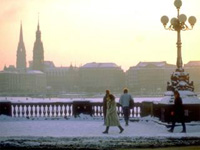 Hamburg OverviewHamburg is a watery city, geographically, historically and
atmospherically. It is Germany's second largest city and lies on
the Elbe River, for centuries a major port and trading centre for
central Europe. The city has a network of canals that rival those
of Venice (it is said to have more bridges than Venice) and is
centred on two artificial lakes that take up eight percent of its
total area. Probably because of all the water, Hamburg is also
known as Germany's 'green city', sporting 1,400 parks and gardens.
Modern buildings sit cheek by jowl with historic Baroque and
Renaissance architecture, and by night the neon lights dazzle
all-night revellers, particularly in the city's notorious red light
district, the Reeperbahn. Hamburg was founded in 810 by Charlemagne and earned its place
in history by becoming the most strategic port in the Hanseatic
League of North German cities which controlled trade in the Baltic
and North Seas between the 13th and 15th centuries. A great fire
destroyed much of the city in 1842, and a century later World War
II bombing raids again laid it waste, but Hamburg bounced back with
style, thanks to the wealth garnered from its position as a trading
centre. The city's tourist board claims that Hamburg is now home to
more millionaires per capita than any other city in Europe. Most of the sights of interest to tourists in the city are
centred on its maritime traditions, particularly in the harbour
area, where the warehouse district (Alster Arkaden) has been
transformed into an entertaining destination offering a variety of
shops, cafes and restaurants. Hamburg also has a number of lovely
gardens and pretty churches and cathedrals, though there is little
old architecture left in the old town. There are also a number of
museums dedicated to history, art, communications, ethnology, and
even spices. Further afield, Hamburg is the gateway to the seaside
and spa resorts of the Baltic and North Sea coastline. |